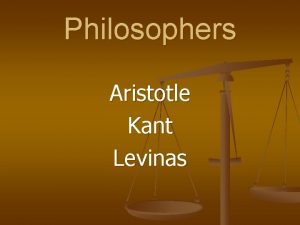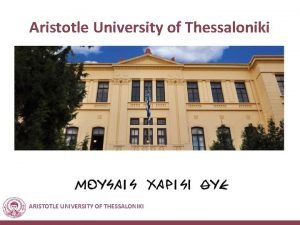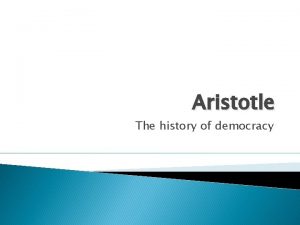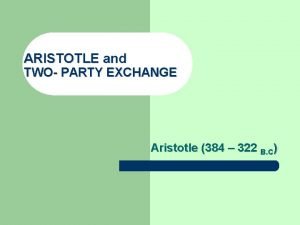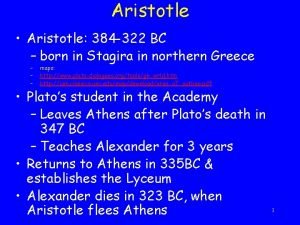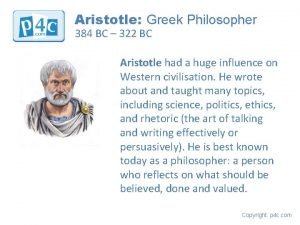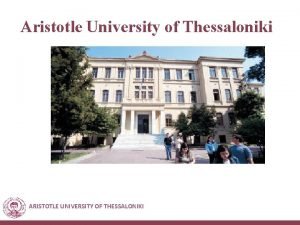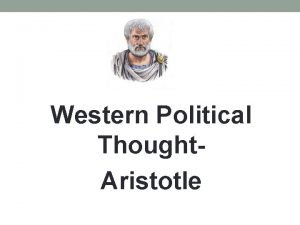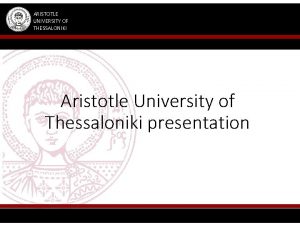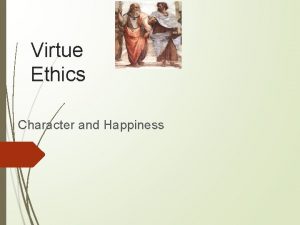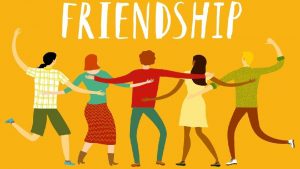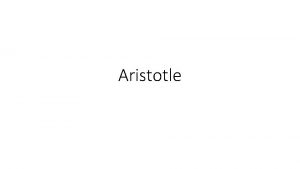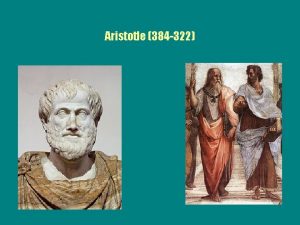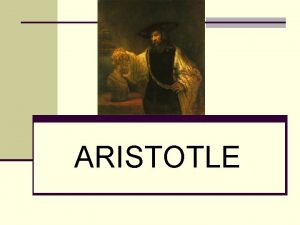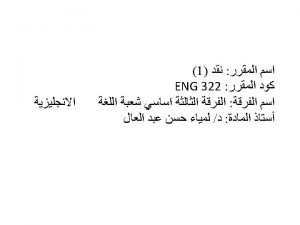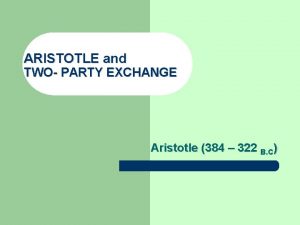Who is Aristotle What are the main parts


















- Slides: 18

Who is Aristotle? What are the main parts of a movie? What does it mean to be Authentic?

What are the parts of a play(movie) according to Aristotle? What is the difference between the first cause and the second cause in a play/movie? Are subplots good? Why?

© 2012. Wanda Teays, all rights reserved.

Aristotle was an ancient Greek Philosopher. Did a little bit of everything but is best known for his work in plays and ethics. Aristotle believed there were 6 main components to a successful play.

PLOT —Plot is on top! The plot is the soul of the movie! CHARACTER —Focus especially on the protagonists’ moral character THOUGHT — Themes and ideas, what motivates the character DIALOGUE — and diction, ” the expression of meaning in words” (Aristotle) MUSIC —-is “embellishment” in that it reinforces theme SPECIAL EFFECTS (“Spectacle” —- Least important says Aristotle—more craft than artistry. (He’d probably be a bit more receptive to today’s special effects)

NITTY GRITTY Movies should have a BEGINNING, MIDDLE and the END For Aristotle this is: the First Cause= Beginning the Complication= Middle the Resolution= End Ideally, the audience should experience a CATHARSIS at the end, like a big sigh of relief!

KEY TERMS � Back story: What happens before the beginning of the movie � First Cause—sets off the story line, sets things in motion � Second Cause—toward the middle of the movie, sets the 2 nd half in motion toward a � Resolution ( = “DENOUEMENT”) where knots are tied. � Catharsis —an outpouring of all the pent-up tension or emotions that have been building.

� The beginning (“First cause”) sets off the chain of events that drives the story. The First Cause happens early in the movie and not before the movie starts.

The second part (“Complication” where a moral conflict on the part of the hero is made clear. ) It ranges from the change of fortune for the hero to the “Second Cause of Action. ” The second cause of action leads to change or “Discovery. ”—the third part, (“the Resolution”) towards the end of the movie.

� COMPLEX plots are Aristotle’s favorites. � What makes them complex? � There’s a “Reversal of Fortune”—-the hero’s fortunes change (from good to bad or vice versa). � “Reversal of Fortune” leads to a “Discovery” —-a revelation or realization that is transformative to the hero � SIMPLE plots are usually thought to have a reversal of fortune but no discovery (some interpret Aristotle to hold that a simple plot may have neither (just be a string of episodes).

� The best plots have a single focus—they are tight!—not a bunch of tangents going off in all directions The best movies: � Have no subplots and � are not episodic—The story wraps up at the end, doesn’t leave us dangling. � Franchise films-the “to be continued” types of movies are definitely not for Aristotle!

Joseph Booker: Argues that all stories follow one of 7 basic plots. He researched his book for 34 years before publishing it. Overcoming the Monster. Rags to Riches. The Quest. Voyage and Return. Comedy. Tragedy. Rebirth.

1. THE ORDINARY WORLD. The hero, uneasy, uncomfortable or unaware, is introduced sympathetically so the audience can identify with the situation or dilemma. The hero is shown against a background of environment, heredity, and personal history. Some kind of polarity in the hero’s life is pulling in different directions and causing stress. 2. THE CALL TO ADVENTURE. Something shakes up the situation, either from external pressures or from something rising up from deep within, so the hero must face the beginnings of change. 3. REFUSAL OF THE CALL. The hero feels the fear of the unknown and tries to turn away from the adventure, however briefly. Alternately, another character may express the uncertainty and danger ahead. 4. MEETING WITH THE MENTOR. The hero comes across a seasoned traveler of the worlds who gives him or her training, equipment, or advice that will help on the journey. Or the hero reaches within to a source of courage and wisdom. 5. CROSSING THE THRESHOLD. At the end of Act One, the hero commits to leaving the Ordinary World and entering a new region or condition with unfamiliar rules and values.

6. TESTS, ALLIES AND ENEMIES. The hero is tested and sorts out allegiances in the Special World. 7. APPROACH. The hero and newfound allies prepare for the major challenge in the Special world. 8. THE ORDEAL. Near the middle of the story, the hero enters a central space in the Special World and confronts death or faces his or her greatest fear. Out of the moment of death comes a new life. 9. THE REWARD. The hero takes possession of the treasure won by facing death. There may be celebration, but there is also danger of losing the treasure again. 10. THE ROAD BACK. About three-fourths of the way through the story, the hero is driven to complete the adventure, leaving the Special World to be sure the treasure is brought home. Often a chase scene signals the urgency and danger of the mission. 11. THE RESURRECTION. At the climax, the hero is severely tested once more on the threshold of home. He or she is purified by a last sacrifice, another moment of death and rebirth, but on a higher and more complete level. By the hero’s action, the polarities that were in conflict at the beginning are finally resolved. 12. RETURN WITH THE ELIXIR. The hero returns home or continues the journey, bearing some element of the treasure that has the power to transform the world as the hero has been transformed.


I think I said you were going to have a test tomorrow… Let’s have the test on Wednesday. It will cover the First Power. Point, on Ethical Philosophies, and the second Power. Point, on Aristotle’s Poetic’s. Normally this would get split up into a test and a quiz, but we will just combine these both together on Wednesday. You can spend the last 10 minutes studying.

Think of your Favorite Movie (write the title) Identify which of the 7 Plots that your Movie is Briefly explain each for your movie 1. 2. 3. 4. 5. 6. Backstory First Cause Complication/Reversal of Fortune Second Cause Resolution Catharsis (Is there one? Explain) Due 1/15/2020

What does it mean to be authentic according to the article? (What is authenticity? ) What factors can be considered when talking about authenticity? What challenges might one face when seeking to be authentic? Should people/society place more importance on being “authentic” individuals?
 Insidan region jh
Insidan region jh Be going to
Be going to Main idea examples
Main idea examples Void main int main
Void main int main Hát kết hợp bộ gõ cơ thể
Hát kết hợp bộ gõ cơ thể Lp html
Lp html Bổ thể
Bổ thể Tỉ lệ cơ thể trẻ em
Tỉ lệ cơ thể trẻ em Chó sói
Chó sói Tư thế worms-breton
Tư thế worms-breton Hát lên người ơi alleluia
Hát lên người ơi alleluia Kể tên các môn thể thao
Kể tên các môn thể thao Thế nào là hệ số cao nhất
Thế nào là hệ số cao nhất Các châu lục và đại dương trên thế giới
Các châu lục và đại dương trên thế giới Cong thức tính động năng
Cong thức tính động năng Trời xanh đây là của chúng ta thể thơ
Trời xanh đây là của chúng ta thể thơ Cách giải mật thư tọa độ
Cách giải mật thư tọa độ Phép trừ bù
Phép trừ bù Phản ứng thế ankan
Phản ứng thế ankan



















